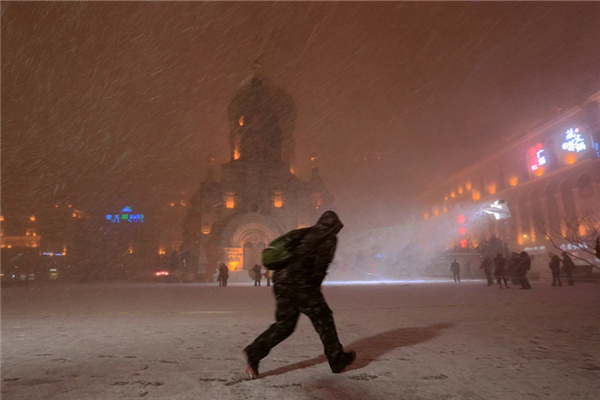

Rebounds in some domestic economic indicators - real estate, auto sales, new investments and electrical utilities - in the first quarter of this year may signal a recovery of the Chinese economy. Are these signs that the financial crisis has stopped worsening and that Chinese economy has bottomed out and will take the lead on the road to recovery?
Experts gave different answers on the website of Caijing magazine.
Yes
Sun Mingchun, economist with Nomura International:
We forecast China's real economic growth to be 8 percent in 2009.
China's economy will see a V-shaped recovery this year, with the worst periods being the fourth quarter of 2008 and the first quarter of this year. Economic growth will begin to gain speed in the second quarter. We expect the economic rate to rise to 7.5 percent in the second quarter and reach 10 percent in the first quarter of 2010.
China's economic growth is now mainly buoyed by investment and dragged down by dwindling exports. With the adjustment of global inventories coming to an end, the downward trend of exports is likely to slow down in coming months.
We should not overestimate the effects of dwindling exports on the economy. Export revenues contribute to 33 percent of the country's GDP, but only 20 percent of the industrial output.
The stimulating effect of investment to the economy will gradually become stronger and more evident. Therefore, China's economy is on its way to recovery.
Frank Gong, economist with JPMorgan Chase:
We should not look at year-over-year figures to judge whether China's economy has bottomed out or not.
The year-over-year GDP growth in the first quarter is 6.1 percent, down from 6.8 percent in the last quarter of 2008, owing to last year's large GDP base number. However, the GDP is estimated to grow about 5 percent quarter-over-quarter in the first three months, compared with a quarter-over-quarter growth rate of only 1.5 percent in the last quarter of 2008. The quarter-over-quarter GDP growth rates are likely to rise to 9 percent to 10 percent in the second and third quarters, which means China's economy already bottomed out in the first quarter.
In addition, the March PMI (Purchasing Managers' Index) released by the National Bureau of Statistics of China was up 3 percentage points from 49 percent a month earlier, which indicated economic expansion.
As China's export sector still faces a grim outlook and isn't likely to change for the better for months to come, whether the economy can fully recover will depend on how domestic demand improves. We have seen a continuous trend of improvement in new loans, in consumption, in real estate, in auto sales and in the retail sector.
These have all exceeded previous expectations.
Chinese consumers have a great potential, and if they are confident enough to spend, China's domestic demand will pick up and the economy will make a turn for the better.
No
Lu Lei, professor with Guangdong University of Finance:
Judging from some economic indicators, China's economy appears to have bottomed out, but people holding such a view ignore the real economy, whose recovery usually lags behind the theoretical rebound shown by indicators.
The current "recovery" is largely due to government investment. Although government spending can indeed stimulate demand for some products, there are few signs of the economy growing on its own force, and private investment has not reversed its downward trend. If profits continue to fall, private investment will continue to slow down.
As early as November 2007, China felt the pressure of an economic downturn but did not acknowledge it at the time. Judging from current circumstances, no single country can survive on its own as economies are increasingly intertwined in a globalized world. Many uncertainties continue to hamper the global economic recovery.
For instance, if the troubled US auto industry collapses, it will deal a heavy blow to China's auto-related industries as well as affect the overall demand abroad.
Therefore, I think in the first half of this year, China's economy will benefit from government policies for stimulating the economy, but we should not expect any signs of a substantive global recovery in the second half.
Stephen Green, head of China Research of Standard Chartered Bank:
There is much positive news about the Chinese economy nowadays, which some people say has already stabilized. But it does not represent an immediate recovery or rebound. We think China's economy will see a U-shaped recovery and the real economy will run at the bottom for quite some time, without further deterioration or a conspicuous rebound.
The official PMI rose for the fourth month in a row in March to top 50 percent for the first time in six months, compared with a reverse trend as was shown by brokerage CLSA's PMI survey, which found the index dipped slightly from the previous month to 44.8 percent. We think the official PMI focuses more on large enterprises and large listed companies, while CLSA's PMI is mainly meant to represent small and medium-sized enterprises (SMEs), especially those in the foreign trade sector. The two seemingly conflicting figures actually reflect China's current economic situation, where industries like transportation and equipment manufacturing are the main beneficiaries of government investment whereas SMEs are on a footing that is still quite worrisome.
Our research shows that 20 percent of China's output is related to the external economy and the country's economic slowdown is mainly caused by falling exports. Therefore, China's economic stabilization and recovery will largely depend on positive changes to the environment abroad.
(China Daily 04/20/2009 page2)













